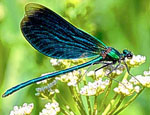High flying Dragonfly - now an aspiring 'Monro-ist

A female Common Hawker dragonfly has been found recently at 830m on the slopes of Munro No. 41. Tom a' Choinich (Carn Eige) which is part of the The Carn Eige Group in the Glen Affric to Kintail area of Highland, Scotland, a popular walking area west of Loch Ness. This is the highest this species has ever been found in the UK.
The pond where the dragonfly was nested was found by Jonathan Willet, The Highland Council's Biodiversity Officer, who commented,
"Being a bit of a dragonfly enthusiast this was a really exciting find, I always have an eye out for dragonflies and was really surprised to see a female egg laying in this pond. Being so high up this must be close to the height limit for breeding in the UK."
Dragonflies are one of the most ancient species surviving in Britain today. Using fossil records, experts have estimated that dragonflies existed here nearly 300 million years.
They have an amazing degree of flexibility in flight. A Dragonfly can fly forwards at up to 35mph but can also fly backwards, change direction in mid-air and hover for up to a minute. They are to the insect world what the Harrier Jump jet is to the world of aviation.
Sadly though, these fascinating creatures are now under threat - 3 of the remaining 42 species have become extinct within the last 40 years and up to a third of the remaining species are now also facing extinction. The challenges they face come from three sources - pollution, pesticides .... and loss of their habitat.
They are often found in fen land-type environments or small, boggy pools where they spend a large proportion of their lives underwater as larvae. Eventually emerging as a winged insect, the adult's flying time is relatively short - sometimes only weeks for the smaller species.
Despite their short life, they are important indicators of water quality. And although they don't bite humans they are a very effective, natural predator of mosquitoes and midges.
So - may be that section of the walk that takes in some boggier terrain may be just that bit more interesting. Let's hope walkers can continue to encounter these fascinating and intrepid creatures.
“Interesting article.”
Andrew Campbell, Birmingham
“Thanks for bringing this to our attention.”
Chris Gay
The views expressed by contributors to this discussion are not necessarily those held by go4awalk.com.




















